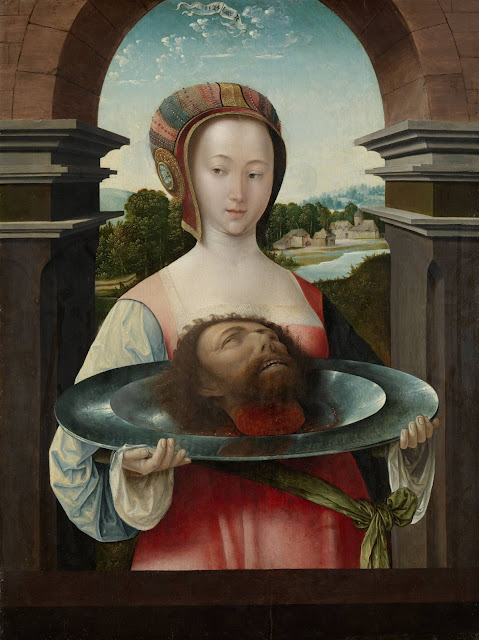 |
| Geertgen tot Sint Jans Tree of Jesse ca. 1500 oil on panel Rijksmuseum |
A medieval tradition of representation informed the early Renaissance painting above. The human ancestry of Christ had long been illustrated with charts showing schematic figures distributed among branches of schematic trees. E.H. Gombrich points out in The Preference for the Primitive (Phaidon, 2002) that the new 15th-century fashion for fully illusionistic figures inhabiting illusionistic space was grafted onto older, non-naturalistic schematic forms. The Tree of Jesse by Geertgen tot Sint Jans of the Netherlands was Gombrich's favorite example of this anomaly – an entire cast of full-sized, three-dimensional, fashionably-dressed courtiers swarming the branches of a modest naturalistic tree – this excess of naturalism creating an overall impression of intense weirdness.
 |
| Geertgen tot Sint Jans The Holy Kinship ca. 1494 oil on panel Rijksmuseum |
 |
| Geertgen tot Sint Jans Adoration of the Magi ca. 1485 oil on panel Rijksmuseum |
 |
| Jan van Scorel Mary Magdalene ca. 1530 oil on panel Rijksmuseum |
 |
| Jan van Scorel Madonna of the daffodils, with Christ Child and donors ca. 1535 oil on panel Museo Thyssen-Bornemisza, Madrid |
 |
| Jan van Scorel Landscape with Bathsheba ca. 1540-45 oil on panel Rijksmuseum |
 |
| Jacob Cornelisz van Oostsanen Salome with the head of John the Baptist 1524 oil on panel Rijksmuseum |
 |
| Jacob Cornelisz van Oostsanen Crucifixion ca. 1507-10 oil on panel Rijksmuseum |
 |
| Carlo Crivelli Mary Magdalene ca. 1480 tempera on panel Rijksmuseum |
 |
| attributed to Francesco Bonsignori St Sebastian ca. 1470-90 oil on canvas Rijksmuseum |
 |
| Maarten van Heemskerck Hercules destroying the Centaur Nessus ca. 1550-60 oil on panel Rijksmuseum |
 |
| Colijn de Coter Lamentation ca. 1510-15 oil on panel Rijksmuseum |
 |
| Giovanni di Paolo di Grazia Crucifixion ca. 1447 tempera on panel Rijksmuseum |
 |
| Aertgen Claesz van Leyden Calling of St Anthony ca. 1530 oil on panel Rijksmuseum |